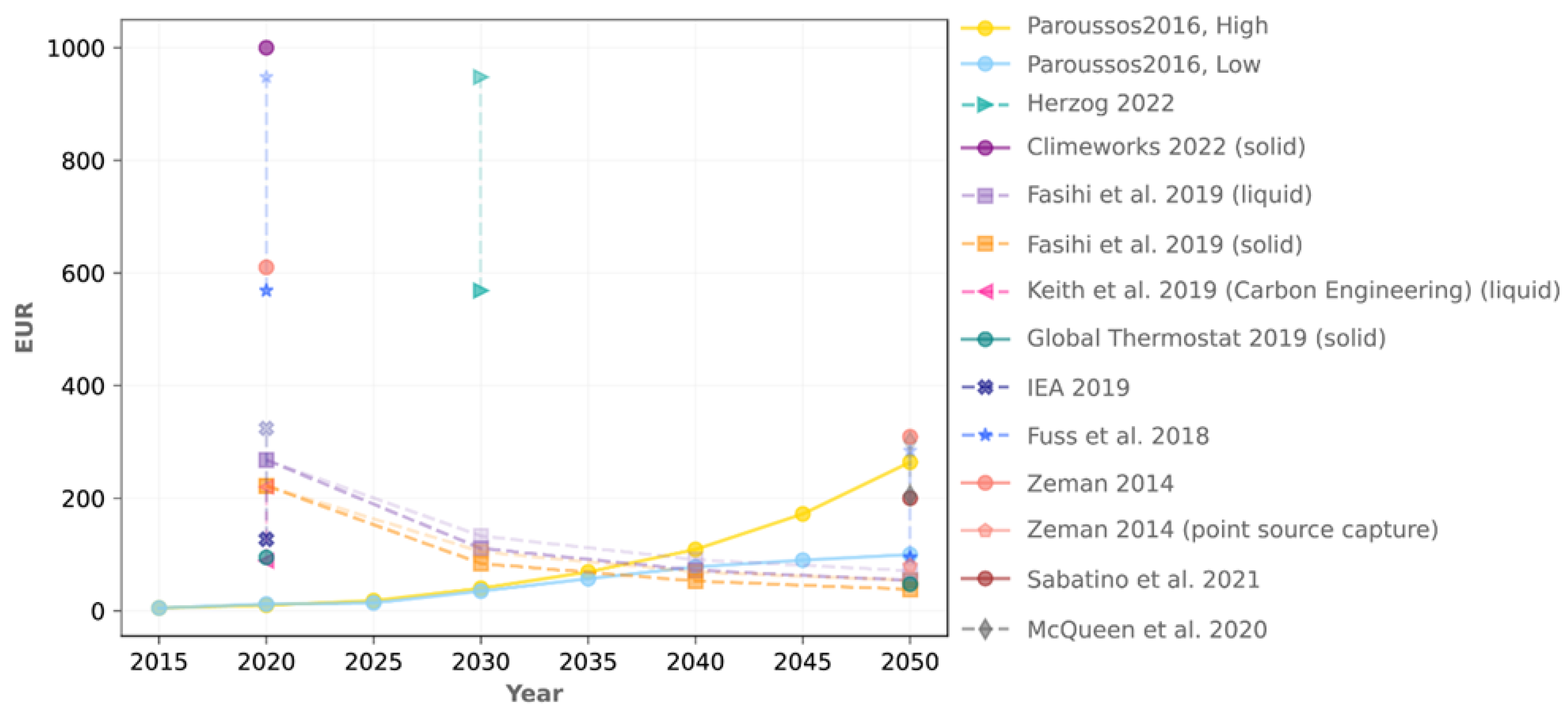The Role of Direct Air Capture in EU’s Decarbonisation and Associated Carbon Intensity for Synthetic Fuels Production
Abstract
1. Introduction
2. DAC State of the Art
2.1. DAC Main Technologies
2.1.1. Solid Adsorption
2.1.2. Liquid Absorption
2.2. Energy Use and Sorbents
2.3. Carbon Footprint
3. Synthetic Fuels Pathways
3.1. Definition and State of the Art
3.2. EU Legislation
3.3. Case Studies
4. Data and Methodology
5. Results
6. Additional Considerations
6.1. CO2 Transport and Permanent Storage
6.2. Area and Water Requirements
6.3. DAC Costs and the Future CO2 Pricing Boundary Condition for Technology Costs
6.4. DAC Projects
7. Discussion
8. Conclusions
- A grid carbon intensity of 468 gCO2e/kWh is the threshold below which DAC can deliver negative emissions. Currently, DAC powered by the grid electricity mix does not provide negative emissions in five EU countries (Bulgaria, Cyprus, Czech Republic, Estonia, and Poland); however, the lower grid carbon intensities would allow this in 2050 REF2020 and 2030 FF55.
- The average negative emissions using DAC in the EU range from −0.407 to 0.794 tCO2e/tCO2 captured for the different years and scenarios. If only PV&Wind are used to power DAC, all countries would already be able today to obtain negative emissions of at least 0.81 tCO2e/tCO2 captured.
- For the production of the considered fuels, currently only a few countries would be able to produce them with a lower carbon footprint than their fossil equivalent using the grid, and only Sweden would be able to comply with the REDII threshold (only for e-methane).
- The maximum grid carbon intensities that allow production of the selected fuels with lower or equal carbon footprints than their fossil equivalent are 96, 121, and 151 gCO2e/kWh for methane, diesel, and methanol, respectively.
- To comply with the REDII threshold, the maximum grid carbon intensity ranges between 30.2 and 38.8 gCO2e/kWh.
Supplementary Materials
Author Contributions
Funding
Data Availability Statement
Conflicts of Interest
References
- Our World in Data. GHG Emissions by Sector. 2020. Available online: https://ourworldindata.org/ghg-emissions-by-sector (accessed on 20 November 2022).
- IPCC. Special Report: Global Warming of 1.5 °C. Summary for Policymakers. 2018. Available online: https://www.ipcc.ch/sr15/chapter/spm/ (accessed on 20 November 2022).
- IPCC. AR5 Synthesis Report: Climate Change 2014. 2014. Available online: https://www.ipcc.ch/report/ar5/syr/ (accessed on 20 November 2022).
- EASAC. Negative Emission Technologies: What Role in Meeting Paris Agreement Targets? 2018. Available online: https://easac.eu/fileadmin/PDF_s/reports_statements/Negative_Carbon/EASAC_Report_on_Negative_Emission_Technologies.pdf (accessed on 20 November 2022).
- IEA. Net Zero by 2050—A Roadmap for the Global Energy Sector. 2021. Available online: https://www.iea.org/reports/net-zero-by-2050 (accessed on 20 November 2022).
- IEA. Direct Air Capture. 2022. Available online: https://www.iea.org/reports/direct-air-capture (accessed on 20 November 2022).
- Eurostat. Greenhouse Gas Emissions in the EU. 2022. Available online: https://ec.europa.eu/eurostat/statistics-explained/index.php?title=Quarterly_greenhouse_gas_emissions_in_the_EU#Greenhouse_gas_emissions (accessed on 4 March 2022).
- European Commission. Communication from the Commission to the European Parliament, the European Council, the Council, the European Economic and Social Committee and the Committee of the Regions. The European Green Deal. 2019. Available online: https://eur-lex.europa.eu/legal-content/EN/TXT/?uri=COM%3A2019%3A640%3AFIN (accessed on 20 November 2022).
- European Commission. Regulation of the European Parliament and of the Council on Establishing the Framework for Achieving Climate Neutrality and Amending Regulation (EU) 2018/1999 (European Climate Law). 2020. Available online: https://eur-lex.europa.eu/legal-content/EN/TXT/?uri=CELEX%3A32021R1119 (accessed on 20 November 2022).
- European Commission. Communication from the Commission to the European Parliament, the Council, the European Economic and Social Committee and the Committee of the Regions ‘Fit for 55’: Delivering the EU’s 2030 Climate Target on the Way to Climate Neutrality. 2021. Available online: https://eur-lex.europa.eu/legal-content/EN/TXT/?uri=CELEX:52021DC0550 (accessed on 20 November 2022).
- European Commission. Communication from the Commission to the European Parliament, the European Council, the Council, the European Economic and Social Committee and the Committee of the Regions REPowerEU: Joint European Action for More Affordable, Secure and Sustainable Energy. 2022. Available online: https://eur-lex.europa.eu/legal-content/EN/TXT/?uri=COM%3A2022%3A230%3AFIN (accessed on 20 November 2022).
- European Commission. Communication from the Commission to the European Parliament and the Council. Sustainable Carbon Cycles. 2021. Available online: https://eur-lex.europa.eu/legal-content/EN/TXT/?uri=CELEX%3A52021DC0800 (accessed on 20 November 2022).
- European Commission. Innovation Fund. 2020. Available online: https://ec.europa.eu/clima/eu-action/funding-climate-action/innovation-fund_en (accessed on 20 November 2022).
- European Commission. EU-Catalyst Partnership: Request for Proposals of Pioneering Green Technology Projects Is Launched. 2022. Available online: https://ec.europa.eu/info/news/eu-catalyst-partnership-request-proposals-pioneering-green-technology-projects-launched-2022-jan-11_en (accessed on 11 January 2022).
- Rickels, W.; Proelß, A.; Geden, O.; Burhenne, J.; Fridahl, M. Integrating Carbon Dioxide Removal into European Emissions Trading. Front. Clim. 2021, 3, 690023. [Google Scholar] [CrossRef]
- European Commission. In-Depth Analysis in Support on the COM(2018) 773: A Clean Planet for All—A European Strategic Long-Term Vision for a Prosperous, Modern, Competitive and Climate Neutral Economy. 2018. Available online: https://knowledge4policy.ec.europa.eu/publication/depth-analysis-support-com2018-773-clean-planet-all-european-strategic-long-term-vision_en (accessed on 20 November 2022).
- Capros, P.; Zazias, G.; Evangelopoulou, S.; Kannavou, M.; Fotiou, T.; Siskos, P.; De Vita, A.; Sakellaris, K. Energy-system modelling of the EU strategy towards climate-neutrality. Energy Policy 2019, 134, 110960. [Google Scholar] [CrossRef]
- Climeworks. Direct Air Capture Summit 2021. 2021. Available online: https://climeworks.com/news/direct-air-capture-summit-2021 (accessed on 10 January 2022).
- Realmonte, G.; Drouet, L.; Gambhir, A.; Glynn, J.; Hawkes, A.; Köberle, A.C.; Tavoni, M. An inter-model assessment of the role of direct air capture in deep mitigation pathways. Nat. Commun. 2019, 10, 3277. [Google Scholar] [CrossRef] [PubMed]
- Beuttler, C.; Charles, L.; Wurzbacher, J. The Role of Direct Air Capture in Mitigation of Anthropogenic Greenhouse Gas Emissions. Front. Clim. 2019, 1, 10. [Google Scholar] [CrossRef]
- Hanna, R.; Abdulla, A.; Xu, Y.; Victor, D.G. Emergency deployment of direct air capture as a response to the climate crisis. Nat. Commun. 2021, 12, 368. [Google Scholar] [CrossRef]
- Breyer, C.; Fasihi, M.; Bajamundi, C.; Creutzig, F. Direct Air Capture of CO2: A Key Technology for Ambitious Climate Change Mitigation. Joule 2019, 3, 2053–2057. [Google Scholar] [CrossRef]
- Ozkan, M.; Nayak, S.P.; Ruiz, A.D.; Jiang, W. Current status and pillars of direct air capture technologies. iScience 2022, 25, 103990. [Google Scholar] [CrossRef]
- Fasihi, M.; Efimova, O.; Breyer, C. Techno-economic assessment of CO2 direct air capture plants. J. Clean. Prod. 2019, 224, 957–980. [Google Scholar] [CrossRef]
- Erans, M.; Sanz-Pérez, E.S.; Hanak, D.P.; Clulow, Z.; Reiner, D.M.; Mutch, G.A. Direct air capture: Process technology, techno-economic and socio-political challenges. Energy Environ. Sci. 2022, 15, 1360–1405. [Google Scholar] [CrossRef]
- Broehm, M.; Strefler, J.; Bauer, N. Techno-Economic Review of Direct Air Capture Systems for Large Scale Mitigation of Atmospheric CO2. SSRN Electron. J. 2015. [Google Scholar] [CrossRef]
- Sabatino, F.; Grimm, A.; Gallucci, F.; Annaland, M.V.S.; Kramer, G.J.; Gazzani, M. A comparative energy and costs assessment and optimization for direct air capture technologies. Joule 2021, 5, 2047–2076. [Google Scholar] [CrossRef]
- Madhu, K.; Pauliuk, S.; Dhathri, S.; Creutzig, F. Understanding environmental trade-offs and resource demand of direct air capture technologies through comparative life-cycle assessment. Nat. Energy 2021, 6, 1035–1044. [Google Scholar] [CrossRef]
- Keith, D.W.; Holmes, G.; Angelo, D.S.; Heidel, K. A Process for Capturing CO2 from the Atmosphere. Joule 2018, 2, 1573–1594. [Google Scholar] [CrossRef]
- Deutz, S.; Bardow, A. Life-cycle assessment of an industrial direct air capture process based on temperature–vacuum swing adsorption. Nat. Energy 2021, 6, 203–213. [Google Scholar] [CrossRef]
- McQueen, N.; Psarras, P.; Pilorgé, H.; Liguori, S.; He, J.; Yuan, M.; Woodall, C.M.; Kian, K.; Pierpoint, L.; Jurewicz, J.; et al. Cost Analysis of Direct Air Capture and Sequestration Coupled to Low-Carbon Thermal Energy in the United States. Environ. Sci. Technol. 2020, 54, 7542–7551. [Google Scholar] [CrossRef]
- Ishimoto, Y.; Sugiyama, M.; Kato, E.; Moriyama, R.; Tsuzuki, K.; Kurosawa, A. Putting Costs of Direct Air Capture in Context. FCEA Working Paper Series: 002. SSRN Electron. J. 2017. [Google Scholar] [CrossRef]
- Sutherland, B.R. Pricing CO2 Direct Air Capture. Joule 2019, 3, 1571–1573. [Google Scholar] [CrossRef]
- Azarabadi, H.; Lackner, K.S. A sorbent-focused techno-economic analysis of direct air capture. Appl. Energy 2019, 250, 959–975. [Google Scholar] [CrossRef]
- Darunte, L.A.; Oetomo, A.D.; Walton, K.S.; Sholl, D.S.; Jones, C.W. Direct Air Capture of CO2 Using Amine Functionalized MIL-101(Cr). ACS Sustain. Chem. Eng. 2016, 4, 5761–5768. [Google Scholar] [CrossRef]
- Deng, Y.; Li, J.; Miao, Y.; Izikowitz, D. A comparative review of performance of nanomaterials for Direct Air Capture. Energy Rep. 2021, 7, 3506–3516. [Google Scholar] [CrossRef]
- Custelcean, R.; Williams, N.J.; Garrabrant, K.A.; Agullo, P.; Brethomé, F.M.; Martin, H.J.; Kidder, M.K. Direct Air Capture of CO2 with Aqueous Amino Acids and Solid Bis-iminoguanidines (BIGs). Ind. Eng. Chem. Res. 2019, 58, 23338–23346. [Google Scholar] [CrossRef]
- Sayari, A.; Liu, Q.; Mishra, P. Enhanced Adsorption Efficiency through Materials Design for Direct Air Capture over Supported Polyethylenimine. Chemsuschem 2016, 9, 2796–2803. [Google Scholar] [CrossRef] [PubMed]
- Li, C.; Shi, H.; Cao, Y.; Kuang, Y.; Zhang, Y.; Gao, D.; Sun, L. Modeling and optimal operation of carbon capture from the air driven by intermittent and volatile wind power. Energy 2015, 87, 201–211. [Google Scholar] [CrossRef]
- Breyer, C.; Fasihi, M.; Aghahosseini, A. Carbon dioxide direct air capture for effective climate change mitigation based on renewable electricity: A new type of energy system sector coupling. Mitig. Adapt. Strateg. Glob. Chang. 2020, 25, 43–65. [Google Scholar] [CrossRef]
- USingh, U.; Colosi, L.M. Capture or curtail: The potential and performance of direct air capture powered through excess renewable electricity. Energy Convers. Manag. X 2022, 15, 100230. [Google Scholar] [CrossRef]
- Wohland, J.; Witthaut, D.; Schleussner, C.-F. Negative Emission Potential of Direct Air Capture Powered by Renewable Excess Electricity in Europe. Earth’s Futur. 2018, 6, 1380–1384. [Google Scholar] [CrossRef]
- Shayegh, S.; Bosetti, V.; Tavoni, M. Future Prospects of Direct Air Capture Technologies: Insights From an Expert Elicitation Survey. Front. Clim. 2021, 3, 630893. Available online: https://www.frontiersin.org/article/10.3389/fclim.2021.630893 (accessed on 6 February 2021). [CrossRef]
- Herzog, H.J. Chapter 6: Direct Air Capture. In Greenhouse Gas Removal Technologies; The Royal Society of Chemistry: London, UK, 2022; Available online: https://pubs.rsc.org/en/content/ebook/978-1-83916-199-5 (accessed on 6 February 2021).
- Climeworks. CO2 Removal. Available online: https://climeworks.com/ (accessed on 6 February 2021).
- Climeworks. Climeworks Takes Another Major Step on Its Road to Building Gigaton DAC Capacity. 2022. Available online: https://climeworks.com/news/climeworks-announces-groundbreaking-on-mammoth?utm_source=Twitter&utm_medium=Social&utm_campaign=mammothannouncement&utm_content=mammothnews (accessed on 28 June 2022).
- Climeworks. Orca: The First Large-Scale Plant. Available online: https://climeworks.com/roadmap/orca (accessed on 8 September 2021).
- Carbon Engineering. Carbon Engineering. Available online: https://carbonengineering.com/our-story/ (accessed on 20 February 2003).
- McQueen, N.; Gomes, K.V.; McCormick, C.; Blumanthal, K.; Pisciotta, M.; Wilcox, J. A review of direct air capture (DAC): Scaling up commercial technologies and innovating for the future. Prog. Energy 2021, 3, 032001. [Google Scholar] [CrossRef]
- Tavoni, M.; Socolow, R. Modeling meets science and technology: An introduction to a special issue on negative emissions. Clim. Chang. 2013, 118, 1–14. [Google Scholar] [CrossRef]
- Realmonte, G.; Drouet, L.; Gambhir, A.; Glynn, J.; Hawkes, A.; Köberle, A.C.; Tavoni, M. Reply to “High energy and materials requirement for direct air capture calls for further analysis and R&D”. Nat. Commun. 2020, 11, 10–11. [Google Scholar] [CrossRef]
- Chatterjee, S.; Huang, K.-W. Unrealistic energy and materials requirement for direct air capture in deep mitigation pathways. Nat. Commun. 2020, 11, 10–12. [Google Scholar] [CrossRef]
- Lin, Q.; Zhang, X.; Wang, T.; Zheng, C.; Gao, X. Technical Perspective of Carbon Capture, Utilization, and Storage. Engineering 2022, 14, 27–32. [Google Scholar] [CrossRef]
- De Jonge, M.M.; Daemen, J.; Loriaux, J.M.; Steinmann, Z.J.; Huijbregts, M.A. Life cycle carbon efficiency of Direct Air Capture systems with strong hydroxide sorbents. Int. J. Greenh. Gas Control 2018, 80, 25–31. [Google Scholar] [CrossRef]
- Climeworks. Direct Air Capture Summit 2020. 2020. Available online: https://climeworks.com/news/direct-air-capture-summit-2020 (accessed on 8 September 2020).
- Liu, C.M.; Sandhu, N.K.; McCoy, S.T.; Bergerson, J.A. A life cycle assessment of greenhouse gas emissions from direct air capture and Fischer-Tropsch fuel production. Sustain. Energy Fuels 2020, 4, 3129–3142. [Google Scholar] [CrossRef]
- Marchese, M.; Buffo, G.; Santarelli, M.; Lanzini, A. CO2 from direct air capture as carbon feedstock for Fischer-Tropsch chemicals and fuels: Energy and economic analysis. J. CO2 Util. 2021, 46, 101487. [Google Scholar] [CrossRef]
- Malins, C. What role is there for electrofuel technologies in European transport’s low carbon future? Cerulogy Rep. 2017, 1–86. [Google Scholar]
- Panoutsou, C.; Germer, S.; Karka, P.; Papadokostantakis, S.; Kroyan, Y.; Wojcieszyk, M.; Maniatis, K.; Marchand, P.; Landalv, I. Advanced biofuels to decarbonise European transport by 2030: Markets, challenges, and policies that impact their successful market uptake. Energy Strat. Rev. 2021, 34, 100633. [Google Scholar] [CrossRef]
- EU. Directive (EU) 2018/2001 of the European Parliament and of the Council of 11 December 2018 on the promotion of the use of energy from renewable sources (recast). Off. J. Eur. Union 2018, L 328, 82–209. [Google Scholar]
- Soler, A. A look into the role of e-fuels in the transport system in Europe (2030–2050) (literature review): Concawe Low Carbon Pathways Joint Group (LCP JG). Concawe Rev. 2019, 28, 4–22. [Google Scholar]
- JEC v5 WtT-and-BEST. Database on Facilities for the Production of Advanced Liquid and Gaseous Biofuels for Transport. IEA Bioenergy Task 39. Available online: https://demoplants.best-research.eu/ (accessed on 17 June 2022).
- Styring, P.; Dowson, G.R.M.; Tozer, I.O. Synthetic Fuels Based on Dimethyl Ether as a Future Non-Fossil Fuel for Road Transport from Sustainable Feedstocks. Front. Energy Res. 2021, 9, 663331. Available online: https://www.frontiersin.org/article/10.3389/fenrg.2021.663331 (accessed on 12 May 2022). [CrossRef]
- Transport & Environment. Magic Green Fuels: Why Synthetic Fuels in Cars Will not Solve Europe’s Pollution Problems. 2021. Available online: https://www.transportenvironment.org/discover/magic-green-fuels-why-synthetic-fuels-in-cars-will-not-solve-europes-pollution-problems/ (accessed on 12 May 2022).
- Sebos, I. Fossil fraction of CO2 emissions of biofuels. Carbon Manag. 2022, 13, 154–163. [Google Scholar] [CrossRef]
- Svanberg, M.; Ellis, J.; Lundgren, J.; Landälv, I. Renewable methanol as a fuel for the shipping industry. Renew. Sustain. Energy Rev. 2018, 94, 1217–1228. [Google Scholar] [CrossRef]
- CWulf, C.; Zapp, P.; Schreiber, A. Review of Power-to-X Demonstration Projects in Europe. Front. Energy Res. 2020, 8, 191. Available online: https://www.frontiersin.org/article/10.3389/fenrg.2020.00191 (accessed on 12 May 2022).
- European Commission. Horizon Europe. Available online: https://ec.europa.eu/info/research-and-innovation/funding/funding-opportunities/funding-programmes-and-open-calls/horizon-europe_en (accessed on 12 May 2022).
- CINEA. Connecting Europe Facility. Available online: https://ec.europa.eu/inea/en/connecting-europe-facility (accessed on 12 May 2022).
- European Commission. InvestEU. Available online: https://ec.europa.eu/info/funding-tenders/find-funding/eu-funding-programmes/investeu_en (accessed on 12 May 2022).
- Bos, M.J.; Kersten, S.R.A.; Brilman, D.W.F. Wind power to methanol: Renewable methanol production using electricity, electrolysis of water and CO2 air capture. Appl. Energy 2020, 264, 114672. [Google Scholar] [CrossRef]
- Prats-Salvado, E.; Monnerie, N.; Sattler, C. Synergies between Direct Air Capture Technologies and Solar Thermochemical Cycles in the Production of Methanol. Energies 2021, 14, 4818. [Google Scholar] [CrossRef]
- European Commission. Communication from the Commission to the European Parliament, the Council, the European Economic and Social Committee and the Committee of the Regions A Hydrogen Strategy for a Climate-Neutral Europe; European Commission: Brussels, Belgium, 2020. [Google Scholar]
- European Commission. 2022 State of the Union Address by President von der Leyen. 2022. Available online: https://ec.europa.eu/commission/presscorner/detail/en/SPEECH_22_5493 (accessed on 14 September 2022).
- European Commission. Recovery and Resilience Facility. Available online: https://single-market-economy.ec.europa.eu/industry/strategy/hydrogen/funding-guide/eu-programmes-funds/recovery-and-resilience-facility_en (accessed on 28 October 2022).
- European Commission. State Aid: Commission Approves up to €5.4 Billion of Public Support by Fifteen Member States for an Important Project of Common European Interest in the Hydrogen Technology Value Chain. 2022. Available online: https://ec.europa.eu/commission/presscorner/detail/en/ip_22_4544 (accessed on 15 July 2022).
- European Commission. Communication from the Commission to the European Parliament, the European Council, the Council, the European Economic and Social Committee and the Committee of the Regions, Europe’s Moment: Repair and Prepare for the Next Generation; European Commission: Brussels, Belgium, 2020; p. 18. [Google Scholar]
- European Commission. Delegated Regulation for a Minimum Threshold for GHG Savings of Recycled Carbon Fuels and Annex. Available online: https://energy.ec.europa.eu/publications/delegated-regulation-minimum-threshold-ghg-savings-recycled-carbon-fuels-and-annex_en (accessed on 2 May 2023).
- European Commission. Delegated Regulation on Union Methodology for RFNBOs. Available online: https://energy.ec.europa.eu/publications/delegated-regulation-union-methodology-rfnbos_en (accessed on 2 May 2023).
- European Commission. Proposal for a Regulation of the European Parliament and of the Council on the Use of Renewable and Low-Carbon Fuels in Maritime Transport and Amending Directive 2009/16/EC; European Commission: Brussels, Belgium, 2021. [Google Scholar]
- European Commission. Proposal for a Regulation of the European Parliament and of the Council on Ensuring a Level Playing Field for Sustainable Air Transport; European Commission: Brussels, Belgium, 2021. [Google Scholar]
- Dieterich, V.; Buttler, A.; Hanel, A.; Spliethoff, H.; Fendt, S. Power-to-liquid via synthesis of methanol, DME or Fischer-Tropsch-fuels: A review. Energy Environ. Sci. 2020, 13, 3207–3252. [Google Scholar] [CrossRef]
- Thema, M.; Bauer, F.; Sterner, M. Power-to-Gas: Electrolysis and methanation status review. Renew. Sustain. Energy Rev. 2019, 112, 775–787. [Google Scholar] [CrossRef]
- Prussi, M.; Yugo, M.; De Prada, L.; Padella, M.; Edwards, R.; Lonza, L. JEC Well-to-Tank Report v5; EUR 30269 EN; Publications Office of the European Union: Luxembourg, 2020; ISBN 978-92-76-19926-7. JRC119036. [Google Scholar] [CrossRef]
- European Commission. EU Reference Scenario 2020: Energy, Transport and GHG Emissions: Trends to 2050; Publications Office of the European Union: Luxembourg, 2021; Available online: https://energy.ec.europa.eu/data-and-analysis/energy-modelling/eu-reference-scenario-2020_en (accessed on 12 May 2022).
- De Wild-Scholten, M.; Cassagne, V.; Huld, T. Solar Resources and Carbon Footprint of Photovoltaic Power in Different Regions in Europe. In Proceedings of the 29th EUPVSEC, Amsterdam, The Netherlands, 22–26 September 2014; pp. 3421–3430. [Google Scholar] [CrossRef]
- NREL. Wind LCA Harmonization. 2013. Available online: https://www.nrel.gov/docs/fy13osti/57131.pdf (accessed on 12 May 2022).
- Tenhumberg, N.; Büker, K. Ecological and Economic Evaluation of Hydrogen Production by Different Water Electrolysis Technologies. Chem. Ing. Tech. 2020, 92, 1586–1595. [Google Scholar] [CrossRef]
- Biograce. BioGrace Excel Tool V4. 2015. Available online: https://biograce.net/content/ghgcalculationtools/recognisedtool (accessed on 12 May 2022).
- Bongartz, D.; Doré, L.; Eichler, K.; Grube, T.; Heuser, B.; Hombach, L.E.; Robinius, M.; Pischinger, S.; Stolten, D.; Walther, G.; et al. Comparison of light-duty transportation fuels produced from renewable hydrogen and green carbon dioxide. Appl. Energy 2018, 231, 757–767. [Google Scholar] [CrossRef]
- Ruokonen, J.; Nieminen, H.; Dahiru, A.R.; Laari, A.; Koiranen, T.; Laaksonen, P.; Vuokila, A.; Huuhtanen, M. Modelling and Cost Estimation for Conversion of Green Methanol to Renewable Liquid Transport Fuels via Olefin Oligomerisation. Processes 2021, 9, 1046. [Google Scholar] [CrossRef]
- National Petroleum Council. Carbon Capture, Use, and Storage (CCUS) Report. 2019. Available online: https://dualchallenge.npc.org/downloads.php (accessed on 18 May 2022).
- Bui, M.; Adjiman, C.S.; Bardow, A.; Anthony, E.J.; Boston, A.; Brown, S.; Fennell, P.S.; Fuss, S.; Galindo, A.; Hackett, L.A.; et al. Carbon capture and storage (CCS): The way forward. Energy Environ. Sci. 2018, 11, 1062–1176. [Google Scholar] [CrossRef]
- Kearns, D.; Liu, H.; Consoli, C. Technology Readiness and Costs of CCS. 2021. Available online: https://www.globalccsinstitute.com/resources/publications-reports-research/technology-readiness-and-costs-of-ccs/ (accessed on 18 May 2022).
- IPCC. Carbon Capture and Storage. 2018. Available online: https://www.ipcc.ch/site/assets/uploads/2018/03/srccs_wholereport.pdf (accessed on 18 May 2022).
- European Commission. Implementation of the CCS Directive. 2009. Available online: https://ec.europa.eu/clima/eu-action/carbon-capture-use-and-storage/implementation-ccs-directive_es (accessed on 18 May 2022).
- European Commission. Communication from the Commission to the European Parliament, the Council, the European Economic and Social Committee and the Committee of the Regions on the Future of Carbon Capture and Storage in Europe. 2013. Available online: https://eur-lex.europa.eu/legal-content/EN/ALL/?uri=CELEX%3A52013DC0180 (accessed on 18 May 2022).
- Northern Lights. What We Do. Available online: https://norlights.com/what-we-do/ (accessed on 18 May 2022).
- Equinor. Northern Lights. Available online: https://www.equinor.com/energy/northern-lights (accessed on 18 May 2022).
- Trading Economics. EU Carbon Permits. Available online: https://tradingeconomics.com/commodity/carbon#:~:text= (accessed on 4 August 2022).
- IETA. GHG Market Sentiment Survey. 2022. Available online: https://www.ieta.org/resources/Documents/IETAGHGMarketSentimentSurveyReport2022.pdf (accessed on 18 May 2022).
- Lebling, K.; Leslie-Bol, H.; Byrum, Z.; Bridgwater, E. Direct Air Capture: Resource Considerations and Costs for Carbon Removal. 2022. Available online: https://www.wri.org/insights/direct-air-capture-resource-considerations-and-costs-carbon-removal (accessed on 5 July 2022).
- ING. Rising Carbon Prices Increase Viability of Low-Carbon Technologies. 2022. Available online: https://think.ing.com/articles/rising-carbon-prices-increase-viability-of-low-carbon-technologies (accessed on 20 March 2022).
- ZEP. The Cost of Subsurface Storage of CO2. 2019. Available online: https://zeroemissionsplatform.eu/wp-content/uploads/Cost-of-storage.pdf (accessed on 18 May 2022).
- IEA. Is Carbon Capture too Expensive? 2021. Available online: https://www.iea.org/commentaries/is-carbon-capture-too-expensive (accessed on 20 September 2021).
- Global Thermostat. We Have the Tech to Suck CO2 from the Air—But Can It Suck Enough to Make a Difference? 2019. Available online: https://globalthermostat.com/wp-content/uploads/2019/06/Fast-Company-We-have-the-tech-to-suck-CO2-from-the-air-06.11.19.pdf (accessed on 5 July 2022).
- Fuss, S.; Lamb, W.F.; Callaghan, M.W.; Hilaire, J.; Creutzig, F.; Amann, T.; Beringer, T.; Garcia, W.D.O.; Hartmann, J.; Khanna, T.; et al. Negative emissions—Part 2: Costs, potentials and side effects. Environ. Res. Lett. 2018, 13, 063002. [Google Scholar] [CrossRef]
- Zeman, F. Reducing the Cost of Ca-Based Direct Air Capture of CO2. Environ. Sci. Technol. 2014, 48, 11730–11735. [Google Scholar] [CrossRef]
- Paroussos, L.; Fragkos, P.; Capros, P. A Model-Based Analysis of the European Intended Nationally Determined Contribution. Studies 2016, 7, 16–36. Available online: https://www.iddri.org/sites/default/files/import/publications/st0716_miles-eu-indc-iccs.pdf (accessed on 18 May 2022).
- The Chemical Engineer. Climeworks Pioneering Air-Captured CO2 for Drinks Carbonation. Available online: https://www.thechemicalengineer.com/news/climeworks-pioneering-air-captured-co2-for-drinks-carbonation (accessed on 23 April 2021).
- Zeman, F. Energy and Material Balance of CO2 Capture from Ambient Air. Environ. Sci. Technol. 2007, 41, 7558–7563. [Google Scholar] [CrossRef]
- Climeworks. Capricorn. Available online: https://climeworks.com/roadmap/capricorn (accessed on 20 September 2022).
- Climeworks. Artic Fox. Available online: https://climeworks.com/roadmap/arctic-fox (accessed on 20 September 2022).
- Climeworks. Climeworks Launches Direct Air Capture Plant in Italy. News, 1 October 2018. Available online: https://climeworks.com/news/climeworks-launches-dac-3-plant-in-italy (accessed on 20 September 2022).
- Store&Go. The STORE&GO Demonstration Site at Troia, Italia. Available online: https://www.storeandgo.info/demonstration-sites/italy/ (accessed on 20 September 2022).
- Climeworks. Turning CO₂ into a High-Tech Resource: Carbon Black. Available online: https://climeworks.com/news/turning-co2-to-a-high-tech-resource-carbon-black (accessed on 20 September 2022).
- European Commission. Upscaling and Optimizing Subsurface, In Situ Carbon Mineralization as an Economically Viable Industrial Option. Available online: https://cordis.europa.eu/project/id/764760;https://www.carbfadiferenciadeix.com/direct-air-capture (accessed on 20 September 2022).
- Carbfix. Direct Air Capture. Available online: https://www.carbfix.com/direct-air-capture (accessed on 20 September 2022).
- Carbon Engineering. Air to Fuels. Available online: https://carbonengineering.com/air-to-fuels/ (accessed on 20 September 2022).
- Carbon Engineering. Engineering Begins on UK’s First Large-Scale Facility That Captures Carbon Dioxide out of the Atmosphere, (n.d.). Available online: https://carbonengineering.com/news-updates/uks-first-large-scale-dac-facility/ (accessed on 20 September 2022).
- Air Capture. Available online: https://www.aircapture.com/ (accessed on 20 September 2022).
- Carbon Capture. Available online: https://carboncapture.com/ (accessed on 20 September 2022).
- Carbyon. Available online: https://carbyon.com/%0D%0A (accessed on 20 September 2022).
- Heirloom. Available online: https://www.heirloomcarbon.com (accessed on 20 September 2022).
- Mission Zero Technologies. Available online: https://missionzero.tech (accessed on 20 September 2022).
- Soletair. Available online: https://www.soletairpower.fi/ (accessed on 20 September 2022).

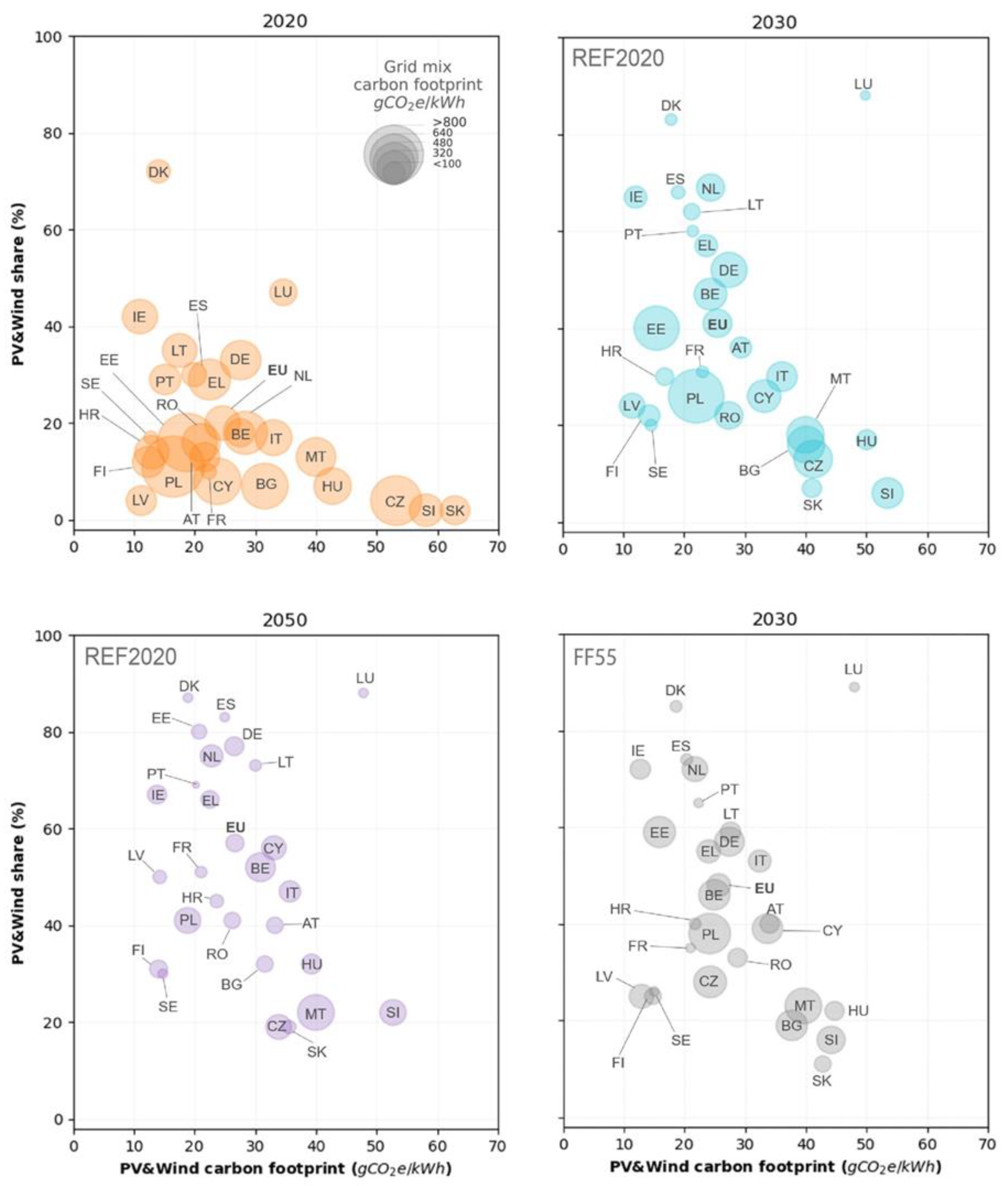
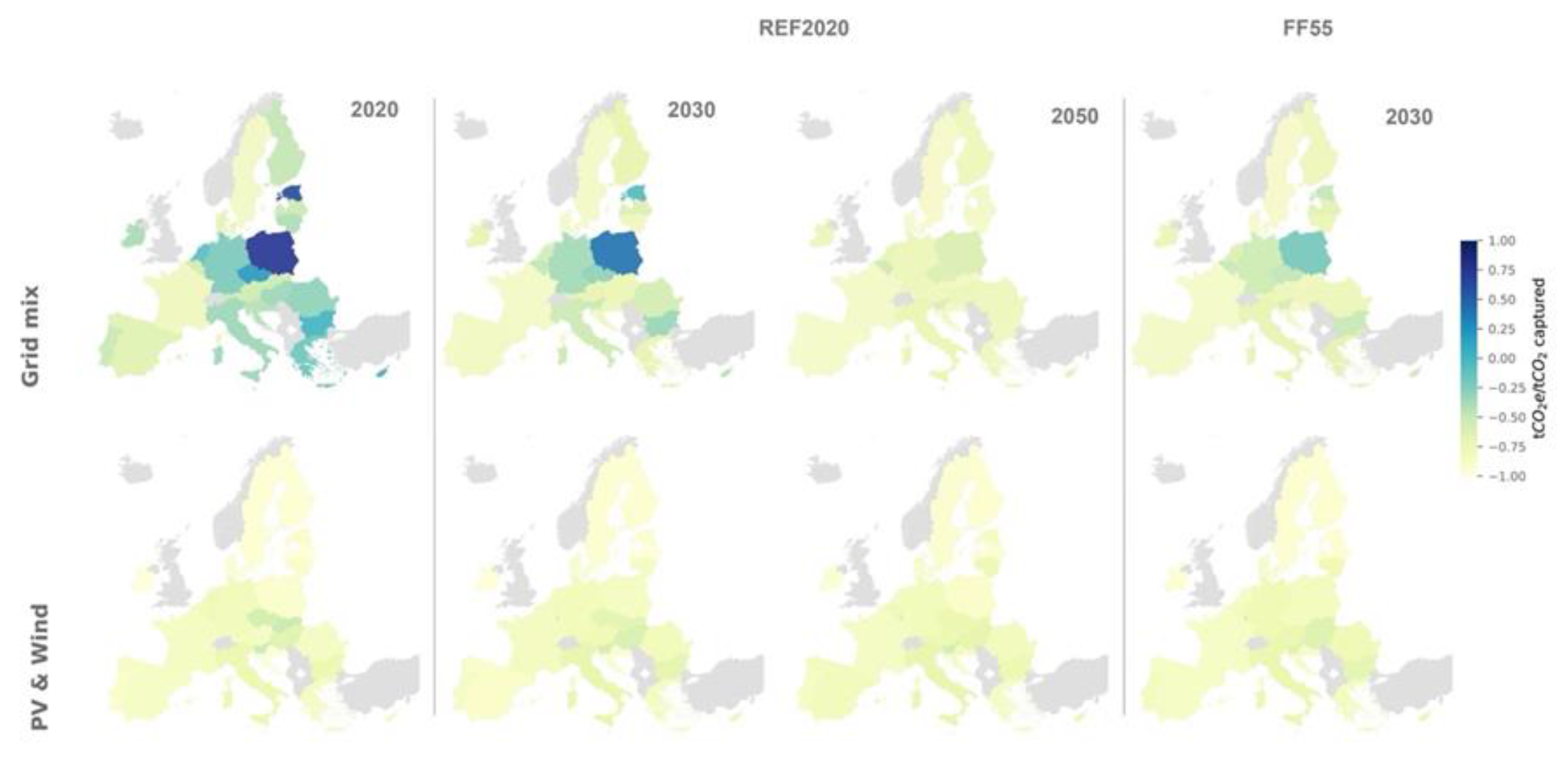
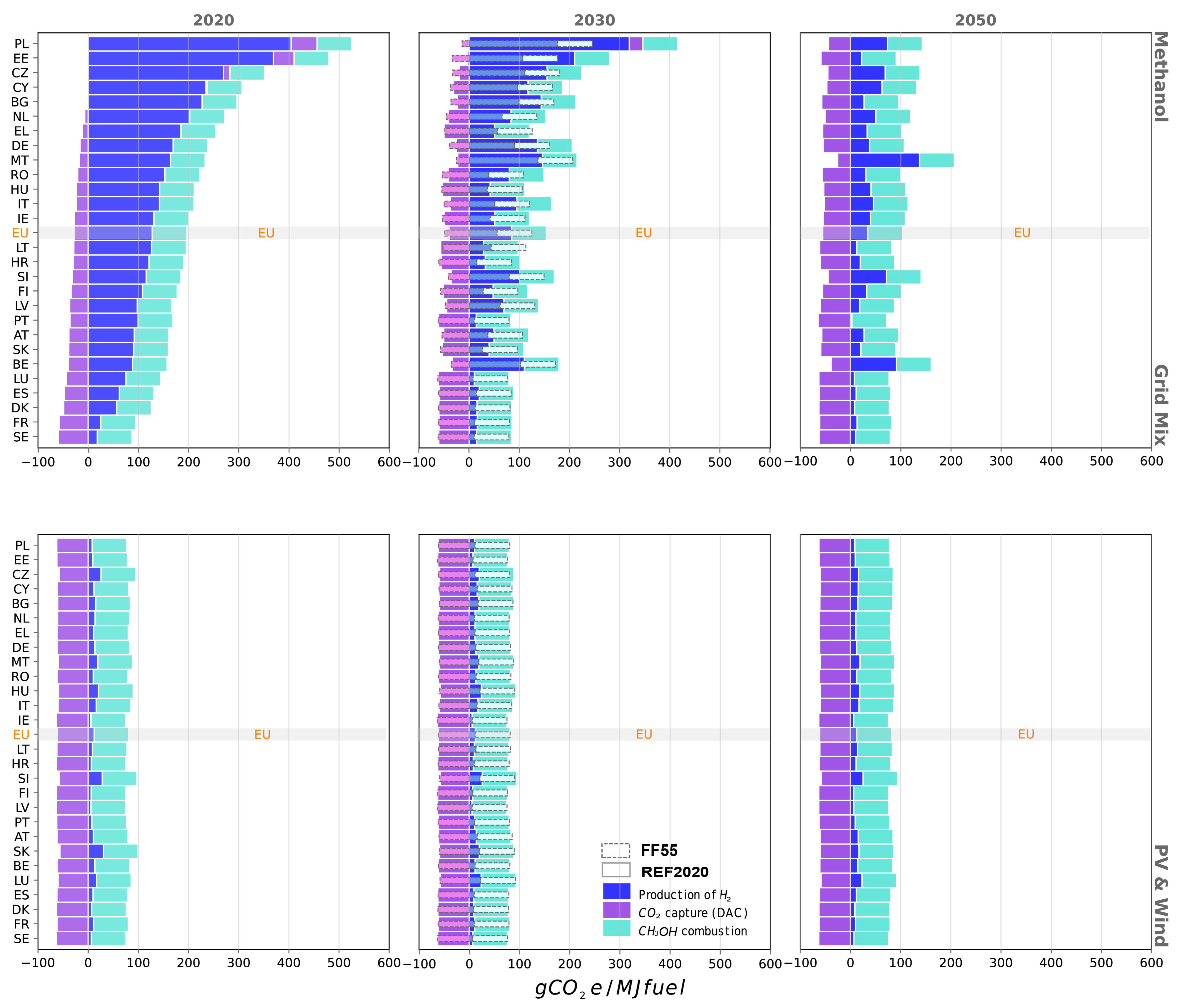
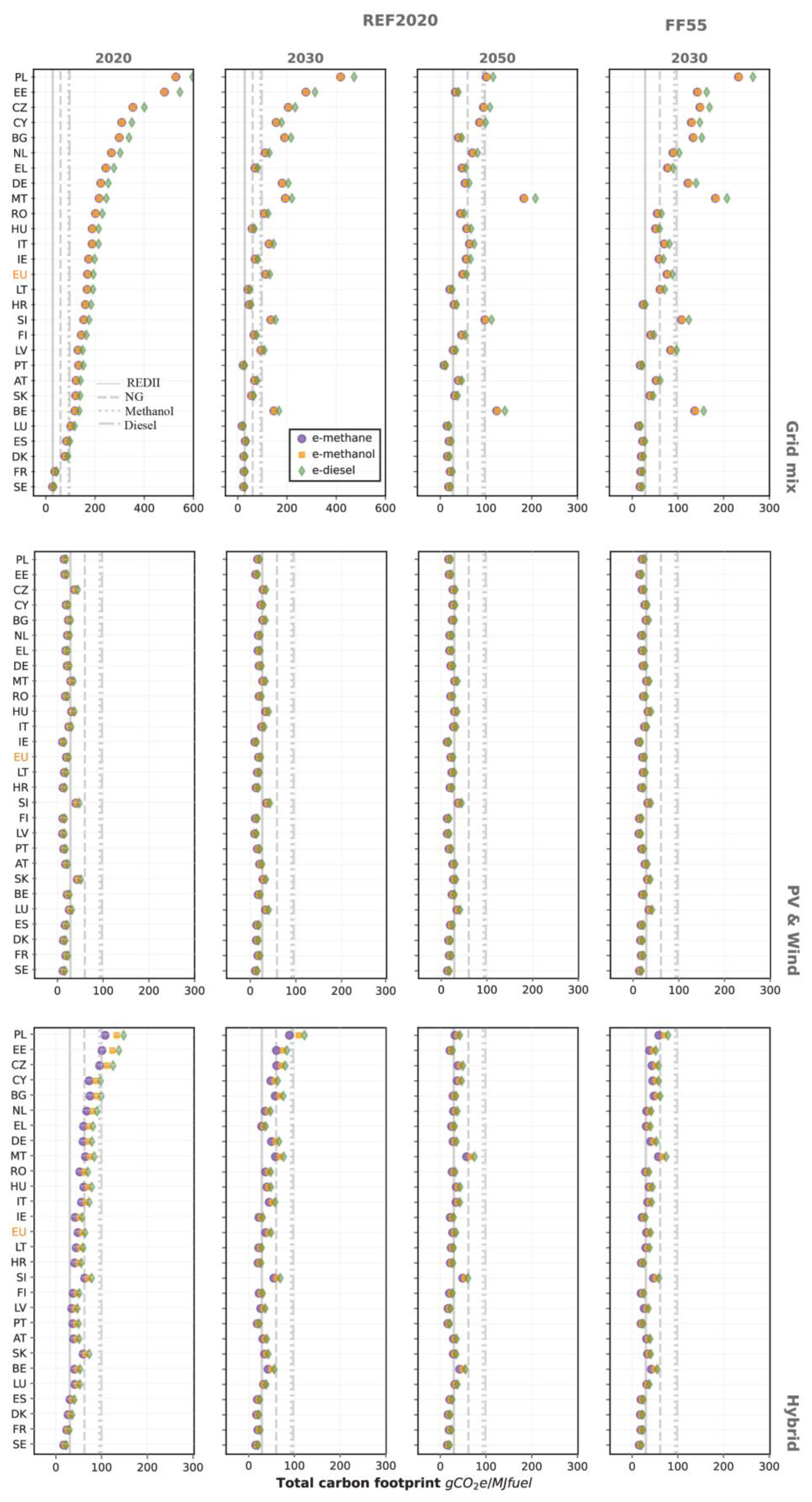
| Process | Value | Source | Notes |
|---|---|---|---|
| Electricity supply for DAC | 2520 MJ/tCO2 captured | [30] | Present values considered (Climeworks) |
| Heat supply for DAC | 11,898 MJ/tCO2 captured | [30] | Present values considered (Climeworks) |
| COP heat pump | 2.51 | [30] | Based on Climeworks design |
| Plant construction carbon footprint | 0.015 gCO2e/gCO2 captured | [30] | Based on a 4 KtCO2/year capacity plant (Climeworks) |
| Sorbent carbon footprint | 0.046 gCO2e/gCO2 captured | [30] | Upper value considered from six adsorbents value range: 0.01–0.046 tCO2e/tCO2 captured |
| Electricity generation by source and carbon intensity | At EU country level | [10,85] | FF55 and REF2020 scenarios |
| PV carbon footprint | At EU country level | [86] | Range of 38–81 gCO2e/kWh (data from 2011) |
| Wind carbon footprint | 3 gCO2e/MJ | [87] | |
| Energy consumption of water electrolysis | 184 MJ/kgH2 | [30,88] | |
| LHV methane | 50 MJ/kgfuel | [89] | |
| CO2 emissions from methane synthesis | 0.6 gCO2e/MJ | [90] | Assuming a grid with a carbon footprint of 392 gCO2e/kWh |
| Methane combustion emissions | 55 gCO2e/MJ | [84] | |
| LHV methanol | 19.9 MJ/kgfuel | [89] | |
| CO2 emissions from methanol synthesis | 2.1 gCO2e/MJ | [90] | Assuming a grid with a carbon footprint of 392 gCO2e/kWh |
| Methanol combustion emissions | 69 gCO2e/MJ | [84] | |
| Natural gas emissions | 64 gCO2e/MJ | [84] | GMCG1 pathway; conditioning and distribution not included |
| Fossil methanol emissions | 91.6 gCO2e/MJ | [84] | GRME1 pathway; conditioning and distribution not included |
| Fossil diesel emissions | 92.2 gCO2e/MJ | [84] | COD1 pathway; conditioning and distribution not included |
| REDII 70% GHG emission reduction | 28.2 gCO2e/MJ | [60] |
Disclaimer/Publisher’s Note: The statements, opinions and data contained in all publications are solely those of the individual author(s) and contributor(s) and not of MDPI and/or the editor(s). MDPI and/or the editor(s) disclaim responsibility for any injury to people or property resulting from any ideas, methods, instructions or products referred to in the content. |
© 2023 by the authors. Licensee MDPI, Basel, Switzerland. This article is an open access article distributed under the terms and conditions of the Creative Commons Attribution (CC BY) license (https://creativecommons.org/licenses/by/4.0/).
Share and Cite
Gonzalez Sanchez, R.; Chatzipanagi, A.; Kakoulaki, G.; Buffi, M.; Szabo, S. The Role of Direct Air Capture in EU’s Decarbonisation and Associated Carbon Intensity for Synthetic Fuels Production. Energies 2023, 16, 3881. https://doi.org/10.3390/en16093881
Gonzalez Sanchez R, Chatzipanagi A, Kakoulaki G, Buffi M, Szabo S. The Role of Direct Air Capture in EU’s Decarbonisation and Associated Carbon Intensity for Synthetic Fuels Production. Energies. 2023; 16(9):3881. https://doi.org/10.3390/en16093881
Chicago/Turabian StyleGonzalez Sanchez, Rocio, Anatoli Chatzipanagi, Georgia Kakoulaki, Marco Buffi, and Sandor Szabo. 2023. "The Role of Direct Air Capture in EU’s Decarbonisation and Associated Carbon Intensity for Synthetic Fuels Production" Energies 16, no. 9: 3881. https://doi.org/10.3390/en16093881
APA StyleGonzalez Sanchez, R., Chatzipanagi, A., Kakoulaki, G., Buffi, M., & Szabo, S. (2023). The Role of Direct Air Capture in EU’s Decarbonisation and Associated Carbon Intensity for Synthetic Fuels Production. Energies, 16(9), 3881. https://doi.org/10.3390/en16093881






